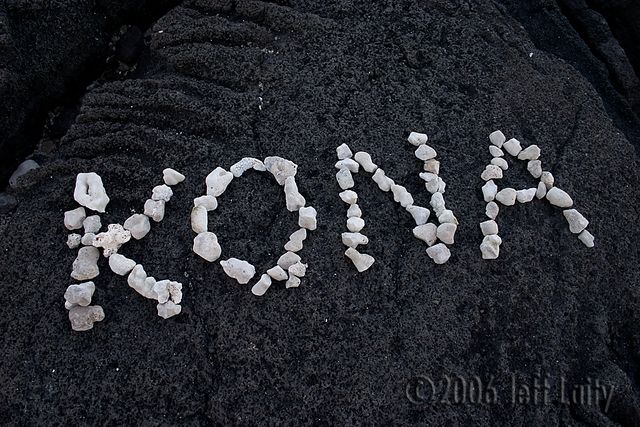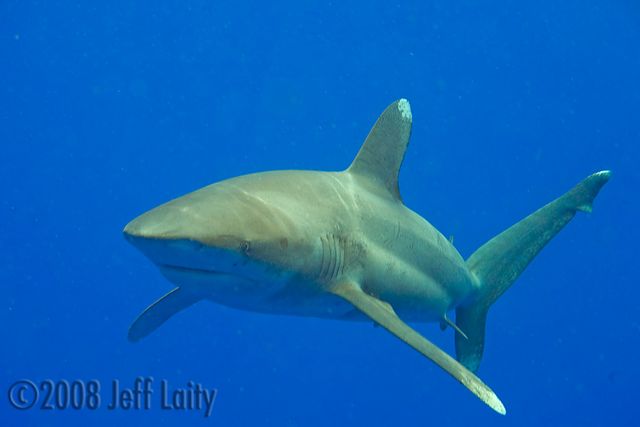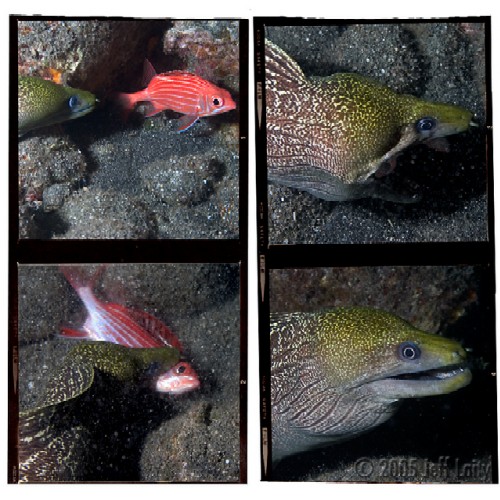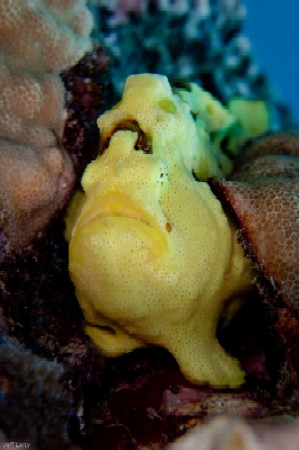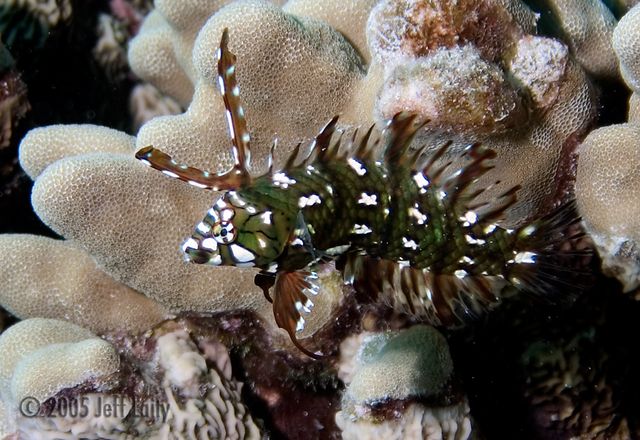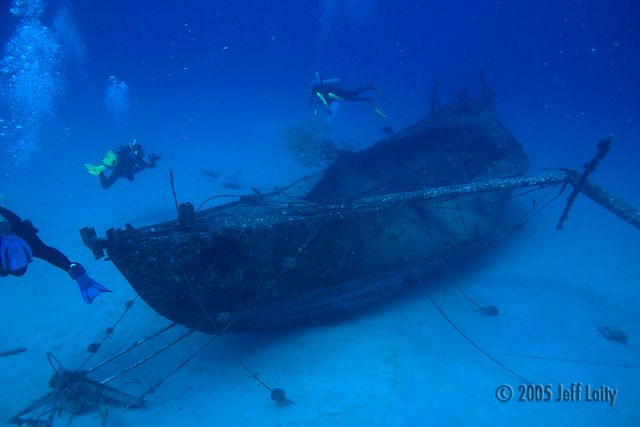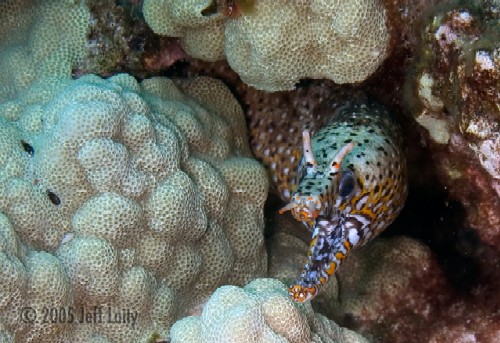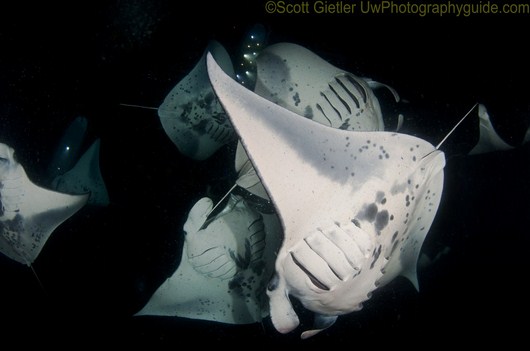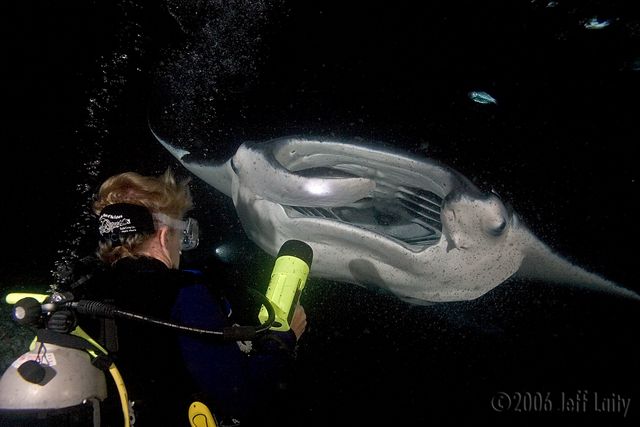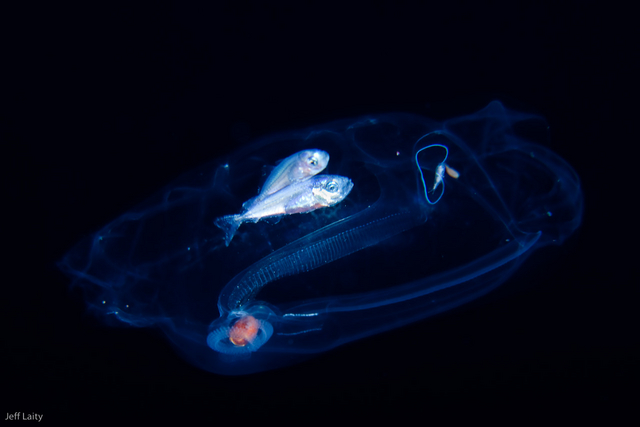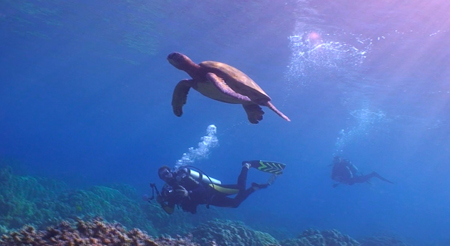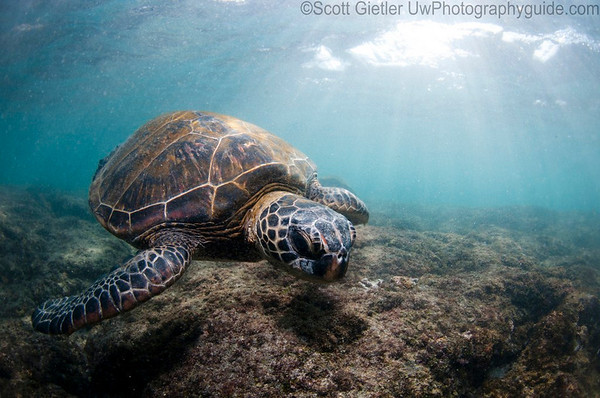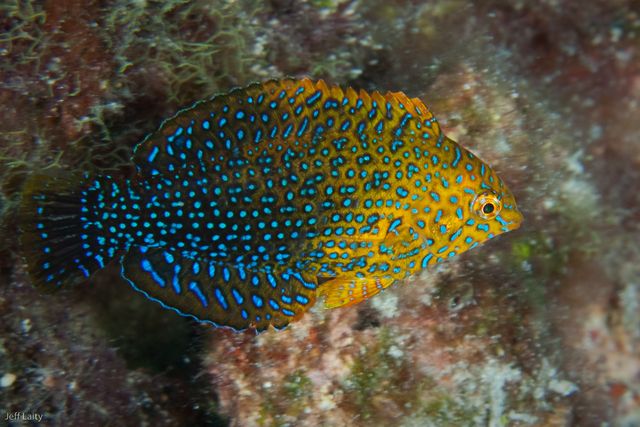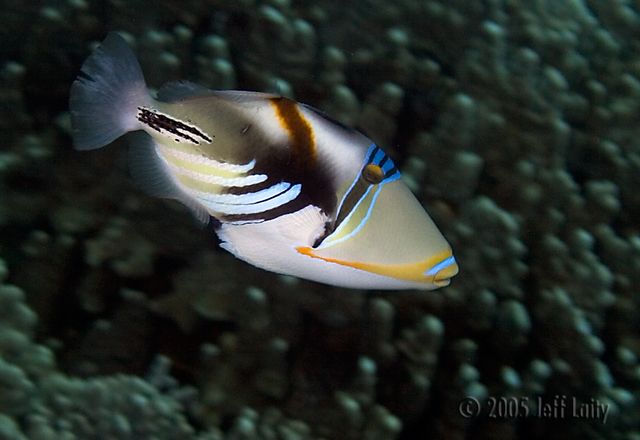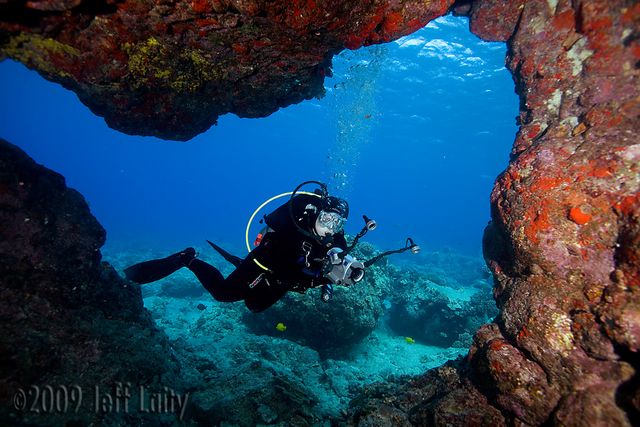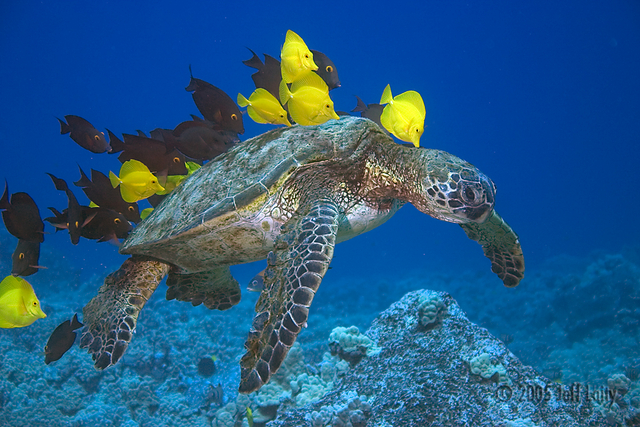
The advantage of diving Kona, on the big island of Hawaii is that it offers something for everyone. Underwater photographers will be hard-pressed to choose a lens before each dive, as you may see anything from tiny nudibranchs to enormous manta rays (and even the occasional whale). If diving isn’t your only reason for travel, the island is full of great topside activities: volcanoes, mountains, waterfalls, rain forests, surfing, snorkeling, even excellent shopping and dining. The laid-back “Hawaiian-style” attitude makes every trip here enjoyable and relaxing.
Kona offers a nice mix of large and small marine life. Visibility is
nice year-round, but don’t expect colorful corals. The great thing about
Kona is its overall atmosphere. The people and the topside scenery make it a wonderful place to relax, even when you’re not diving.
Kona Marine Life
Big Stuff at Kona
You’ll probably see your first sea turtle as you board the dive boat; they like to munch on the algae on the rocks in the harbor. You’re extremely likely to run into these at Place of Refuge (see “Beach Diving” below); if you’re on a dive boat, ask your captain if Turtle Pinnacle, a well-known turtle cleaning station, is an option. You can actually reach this site from shore as well if you’re a good enough navigator; ask your dive operator for more information. PLEASE DO NOT HARASS OR CHASE THE TURTLES.
Hawaii’s spinner dolphins will greet your boat as you motor out of the harbor on your way to the first dive. Between dives, most dive operators will head out into open ocean and look for dolphins or other large animals like Pilot whales, Whale sharks, or Oceanic Whitetip sharks. Snorkeling with any of these is a great wide angle opportunity. There are restrictions on how close a boat can approach these creatures with its engine on, so usually they’ll try to get ahead of the animals, cut the engines, and then see if the animals are still interested in coming over to you. Snorkeling with dolphins is not guaranteed, they have to be in the mood to stay around. Snorkeling with a pilot whale or photographing sharks is a rare bonus.
Eagle rays can be frequently seen. On less frequent occasions divers have also seen barracudas. Eagle rays and Barracudas are “treats” to see, and hopefully you’ll see them at least once on a week-long trip. Jacks can be seen more frequently in Kona, although usually not in large schools like in the Indo-pacific.
Manta Rays – can easily be seen in Kona. See “Night Diving” below.
Hawaiian Fish Life
Some people report that the aquarium trade has taken its toll on the
fish life here, and the reef fish around Kona do tend to be on the
smaller side. However, there are still plenty of fish to see,
especially on the less-dived sites south of Kona.
– Schools of Barracuda can often be found at Honokohau Harbor (see “Beach Diving”)
– Raccoon Butterflyfish make excellent video subjects as they swarm the nests of Sergeant Majors at Eel Cove. Here’s a great video.
– Bicolor and Longfin Anthias are beautiful fish that tend to lurk a little deeper. At Place of Refuge or Honokohau Harbor, drop to the sand at 90′ and look for these fish (and other juvenile species) hiding in isolated coral heads. Bicolor anthias also tend to hang out at the Naked Lady sailboat wreck (see “Dive Sites”)
– Kona is full of eels. “Eel Cove” is a great spot to find a wide variety of morays, including the nifty-looking dragon moray, but you’re likely to come across eels at pretty much any dive site. Look for a bunch of larger fish all staring at the same place in the coral, and occasionally jumping in for a snack – odds are, they’re following a hunting moray as he scares fish out of their dens. Morays also make great subjects on night dives as they hunt.
– Frogfish are hard to find if you don’t know where to look. If you’re beach diving at Honokohau, ask your dive operator if they’ve seen one there recently; they may be able to direct you straight to him.
– Rockmover wrasses make great video subjects if you catch them digging for snacks and moving enormous rocks and chunks of coral out of their way. The juveniles (also called “Dragon Wrasse”) are nice macro subjects. Divers also see pipefish, spanish dancer nudibranchs and boxfish.
Juvenile Rockmover Wrasse
Kona’s Best Dive Sites
Boat Diving in Kona
As an underwater photographer, you may want to ask your dive operator if they run ‘advanced’ charters. These tend to be a little more expensive, but in return you get fewer, more experienced divers on the boat, and often you’ll go to more interesting and distant dive sites.
Diving is usually done in groups of 4-6 divers under one divemaster. This can be a bit hit-or-miss, especially if you’re not on an ‘advanced’ dive. If you have your own buddy and are comfortable in the water, talk to your divemaster and see if they mind you doing your own thing. They’re usually quite flexible with photographers, understanding that you may not want to be in a crowd. If it’s your first day diving with the operator, however, they’ll probably want you to do at least one dive following the leader so they can get a feel for your skills.
Kona Dive Sites
– “Naked Lady” sailboat wreck. Your divemaster is sure to explain the dive site’s name when she briefs you on the dive! This is usually reserved for advanced charters, as the boat is in about 100′ of water. Once it was a fantastic wide-angle wreck photography opportunity, but as the boat has deteriorated it’s no longer quite as photogenic. However, it’s become home to more and more interesting and colorful little fish, so it’s still a great macro dive. It’s pretty tough for videographers to get a good wide-angle shot at this depth unless you’ve got really powerful lights. This is a good site to find bicolor anthias, leaf scorpionfish, and hawaiian green lionfish.
– “Eel Cove.” This is a popular site when there are a lot of beginners on board, as it’s a relatively shallow and protected area. It’s one of my favorites for two reasons: eels and raccoon butterflyfish. Small coral heads fill the “cove” part of this dive site, and if you shine your light into enough of them you might spot something really cool.
In the springtime, if you head around the corner to the northwest, you’ll come across sergeant majors protecting their nests, and swarms of raccoon butterflyfish eager to dive in for a snack.
– “South.” There’s not actually a dive site called “South,” but on advanced charters you may well wind up “going south,” that is, south of Place of Refuge. Any of the sites down here are well worth a visit, as they’re absolutely teeming with fish. There are also some great lava tubes (“Long Lava Tube” may be an advanced dive destination), where you can see some of the creatures that you’d normally only see at night.
– “Turtle Pinnacle.” It’s not a sure thing, but if you reach this dive site at the right time of day (and with few enough divers not to scare all the turtles away) you may see turtles being cleaned by tangs and other colorful fish. It’s worth asking about, especially if you’re on an advanced charter.
Kona Night Diving
There are two night dives in Kona that are simply not to be missed. The first is the manta dive, offered by most dive shops. A crate of dive lights is lowered to the bottom where mantas are known to come in; when they’re lit up, they attract swarms of plankton, making the location even more attractive to the mantas. Divers are instructed to kneel or lie on the rocky bottom in a large circle around the light crate, and direct their own light beams straight up. You might be treated to up to twenty manta rays at a time (though two to five is more common) swooping around to grab mouthfuls of plankton, and barely missing your head. Snorkelers can see the mantas from the surface as well, so this is a good trip to take your non-diving friends on.
Read our complete article on the Kona Manta Ray night dive.
The second night dive is the black water night dive. A boat takes a small handful of advanced divers and motors offshore, eventually cutting the engine and letting the boat drift over deep water. Divers are hooked into 50′ lines which allow them to move up and down in the water columnn without having to worry about getting lost. And then, you just see what comes by! Although most critters are tiny, I’d recommend a medium-to-wide lens for this dive, at least your first time out. It can be extremely hard to focus, and everything is in motion. This is definitely an ADVANCED DIVE, as it can be disorienting to have almost no points of reference in the dark, but it’s worth every penny – even if you don’t manage any good photos.
Kona’s Best Beach Diving
Honokohau Harbor (aka “Ray Bay,” aka “Alua Beach,” aka “Rip-off Reef” for its proximity to the dock) is a terrific site with a wide variety of sights to offer. It’s not really a rip-off when the boat goes here, as it is a much easier entry from a boat! From the beach, you have to deal with a bit of a hike over lava (the cause of Hawaii’s famous black sand beaches) – with camera gear, you should make two or three trips to minimize chances of falling and breaking something. Don’t dive here if the surf is up (which can happen especially in the winter). You’ll know as soon as you park whether it’s do-able! Once you’re in the water, kick out on the surface to the first mooring buoy. Descend along the reef, keeping your eyes out into the blue in case barracuda or dolphins come by. Drop down to the sand in 90′ and look for garden eels, and small coral heads teeming with juvenile fish. Don’t forget to look out in the distance often, as you may see tiger sharks or eagle rays – and look up for schools of barracuda! Head back shallower along the reef and give yourself a nice long safety stop looking for sea turtles.
Place of Refuge (aka “Two-Step,” aka “Honaunau”) is a popular site for snorkelers, freedivers, paddlers, and scuba divers. Any dive shop will be able to give you directions and a map of the dive site. As shore entries go, this one’s easy if you pick the right spot – just watch where all the snorkelers are getting in. Getting out can be a little trickier because urchins like to hide in holes in the rocks, so wear gloves and time your exit with the surge. From shore, head straight out until you see a patch of sand with “Aloha” spelled out in cinder blocks. Head out over the dropoff from here, and down to the sandy patch at about 90′. Like Honokohau, this is a good place to look for anthias in coral heads, and razor wrasse in the sand. When you’re done poking around deep, enjoy a slow ascent back up along the reef. Again, don’t forget to look up and out – dolphins and turtles are a common sight here. The turtles are PROTECTED in this area, so please DO NOT CHASE OR HARASS THEM, in the water or on the sand.
Turtle on a Kona shore dive at Puako, a great place for turtles. Photo by Scott Gietler
Underwater Photography Tips and Best Lenses to Use
We once overheard a professional underwater photographer complain that “Hawaii has the most beautiful fish – and no place to put them!” He was referring to the less-than-photogenic coral formations on the Kona coast, which tend to be gray, white, and kind of rubble-y looking. But he was right about the fish – Kona has some spectacular ones to offer. Just try to aim up into the water column instead of into the coral.
Ask your divemaster for lens suggestions at each site. Locations with interesting structures (lava tubes, arches) make great wide-angle dives, especially if you have a buddy who’s willing to model for you. Many times, the divemaster will be aware of a particular macro critter that can be found at this spot (such as pipefish, frogfish, anthias), and then you might want to switch over to your macro lens. In between dives, you definitely want to get the wide angle lens back on in case you’re dropped into the water for a snorkel with dolphins!
Underwater videographers will probably want to stick with wide-angle lenses most of the time in Kona, as shots of manta rays, sea turtles, hunting eels, schooling fish, sharks and dolphins are ultimately a lot more interesting than video of skittish fish against a backdrop of boring coral. On a typical trip to Kona, I might put the macro lens 10% of the time.
View some Kona underwater videos.
Kona Diving Facts and Tips
Getting There
LAX offers direct flights into Kona airport (KOA). Make sure to put some shorts in your carry-on; Kona airport is all-outdoors, so you’ll want to change into something cooler before you stand around in the sun waiting for your luggage!
You should consider renting a car for your stay in Kona. Even if you don’t plan on beach diving, you may want take advantage of your stay to check out some of the topside attractions.
When to Visit Kona, Visibility, Water temps
Conditions in Kona (the “dry” side of the island) are good for diving nearly every day of the year, so you really can’t go wrong when you pick a date. September and January are the least crowded months, if you’re looking for less-than-full dive boats. If you want the chance to do some whale-watching, November – March is your best bet. The water is a little colder (down to 75 degrees) and the surface a bit choppier in the winter months, and warmer and calmer in the summer (78-81 degrees). Visibility varies depending on rainfall and runoff, but is usually between 75-100′.
Dive boats can almost always find someplace to tuck in out of the chop in the winter, but if you’re doing a lot of shore diving you might want to stick to the calmer summer months.
What to ask
Some dive operators enforce time limits on dive, depth limits and may not allow you to leave the group or solo dive. It’s best to inquire ahead of time about these things if they concern you, and what the maximum group size is, per boat and per guide.
Recommended Equipment
Most dive operators recommend a 5-mil wetsuit for diving in Kona. As an underwater photographer who’s likely to spend a long time sitting still, you might want to bump that up to a 7-mil. Use a thin beanie and gloves, and just unzip the suit if you find you’re getting a bit warm! If you’re going to do any beach diving or snorkeling, you’ll want to use booties and ankle-strap fins (not full-foot fins). If you’re doing a night dive, bring a windbreaker or at least a dry long-sleeved t-shirt for the ride home.
Kona Lodging
If you want to enjoy more than just diving on your trip, The Big Island has plenty of excellent accommodation options. Find out more about where to stay on Hawaii’s Big Island – from the Kona Coast to historic Hilo! At the cheaper end (but still clean and bug-free) is the Kona Seaside Hotel, right across from the town pier and walking distance to all of Alii Drive (Kona’s tourist hub). At the other end of town, right across from Jack’s Diving Locker, is the Royal Kona Resort.
If you’re looking for something more like a romantic getaway, the Sheraton Keauhou is further south from town, and right next to one of the manta ray dive locations.
Wherever you stay, make sure to ask what’s included in the price, or you may find that you pay more than you expected for tax, parking, and extras like wireless or breakfast.
Private Condos in Kona
There are also a lot of condos for rent in the area; some are right in town (across from the Royal Kona). Ask your dive operator, or search online; you may be able to find something that suits your needs for about $100 a night. The biggest benefit of staying in a condo is being able to cook; otherwise you may find that a surprising fraction of your travel budget goes to dining out!
Note from the publisher – nice condo to stay at: In April of 2011 I stayed in a fantastic 1900 sq. ft. condo on Keahou bay, right across the water from the Sheraton Hotel. It was located in a private, gated community. Info on the condo is here. We were a 5-10 minutes south of downtown Kona dive sites, 1 minute away from shore diving with Mantas, 1 minute from a local shopping center, and closer to the Place of Refuge than if we stayed in Kona. This place was literally right on the water with fantastic views, and the place was huge (fits 6 people no problem), we really enjoyed our stay there.
Expenses in Hawaii
Kona is NOT one of the cheaper dive destinations. You can expect to spend about $125 for the basic 2-tank boat trips, and up to $200 or more for 3-tank trips or “advanced” charters. Lodging is generally between $100-$200 per night, and you can easily spend another $100 a day on food if you like to eat out. Nitrox is also expensive here, generally running another $15/tank.
If you want to save money, you should consider renting a condo, eating in, exploring the famous landmarks in Hawaii for free, and doing a lot of beach diving!
Island Hopping in Hawaii
If you have the time and budget, there are other Hawaiian Islands worth visiting, both for diving and topside experiences. Maui is known as one of the most popular holiday destinations in Hawaii, with lots of watersports activities including scuba diving, surfing, and kitesurfing. There are also plenty of gorgeous beachfront villa rentals in Maui. Another favorite is Kauai, known for its lush tropical rainforests and small island feel. Kauai is a great place for avid scuba divers to visit in the summer months, when operators can safely run trips to neighboring Ni’ihau and encounter the endangered Hawaiian monk seal, humpback whales, and more exciting animals. Read more about diving in Kauai here.
Resources on diving Kona
Local Galleries
+ Don’t miss a visit to the Joshua Lambus gallery
Local Info and shore diving:
+ Shore Diving Hawaii (http://shorediving.com/Earth/Hawaii/TBI/index.htm): excellent information on snorkeling and diving from shore
+ Let’s Go Hawaii SCUBA Diving Guide (http://www.letsgo-hawaii.com/diving/): more shore diving information and maps
+ Kona Underwater Photography Society (http://kups.org): Big Island’s underwater photography club
– How to shore dive with a large underwater camera
Dive Operators:
+ Jack’s Diving Locker (http://www.jacksdivinglocker.com/)
+ Big Island Divers (http://www.bigislanddivers.com/)
+ Dive Makai (http://www.divemakai.com/nightDives.htm)
+ Kona Honu (http://www.konahonudivers.com)
+ Torpedo Tours (http://www.torpedotours.com/)
+ Kona Aggressor (http://www.aggressor.com/subpage8.php)
Lodging:
+ Kona Seaside Hotel (http://seasidehotelshawaii.com/HotelKona.aspx)
+ Royal Kona Resort (http://www.royalkona.com)
+ Sheraton Keauhou (http://www.sheratonkeauhou.com)
Dining:
+ Kona Brewery and Pub (http://www.konabrewingco.com/our-pubs/kona-brewery-and-pub) – top-notch beer, pizza and laid-back ambience
+ The Fish Hopper (http://www.fishhopper.com/kona/) – excellent breakfasts as well as seafood dinners
+ Krua Thai Cuisine, on Kuakini near Henry Dr – a relative newcomer that’s getting excellent word-of-mouth
+ Huggo’s (http://www.huggos.com/) – next to the Royal Kona Resort, there’s a ‘fine dining’ restaurant, as well as a beach bar (“Huggo’s on the Rocks”) that turns into a beachside coffee shop in the morning (“Java on the Rocks”)
Further Reading
Best Dive Destinations for Underwater Photography
Manta Ray night dive in Kona
Featured Underwater Photo Artist from Kona: Cynthia Hankins




